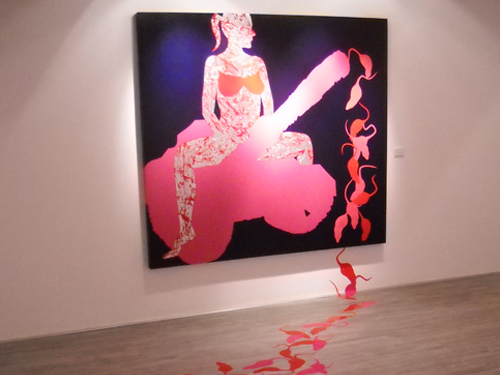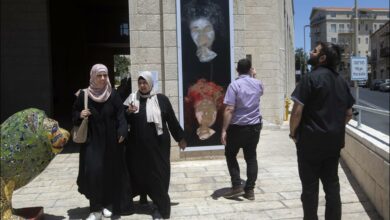
Even in the most dismal of economies, sex sells — and Egyptian artist Nadine Hammam is good at selling it.
In her solo show at Gallery Misr, Hammam offers slicked-up canvases that are something like the visual offspring of Andy Warhol and Jenny Holzer. The first series, “Heartless,” includes five large works depicting shiny, splayed female forms, with Holzer-like statements on love and longing slapped over their silvery, bedazzled bodies. In an adjacent room, the painting installation “Tank Girl” presents a nude woman astride a bright pink tank, which happily ejaculates a generous stream of red and pink plastic rats over the gallery floor. The result of the whole mix is a lesson in the perils of half-heartedly employing the sexy grrl power tropes of third-wave feminism in ways that end up perpetuating the very hierarchies they were meant to challenge.
The work is, at least, fun to look at. Hammam has shown similar paintings in Cairo over the past four years, including her first solo show, “Akl Aish,” (“Earning A Living”) at the Townhouse gallery in 2008, and later “I’m For Sale” at Safar Khan in 2010. Here, she presents similarly abstracted, highly designed images featuring the anonymous silhouettes of female nudes set against a solid background. It’s work that has very clear, traditional Pop references; perhaps that’s why the paintings are somewhat reminiscent of those old iPod ads featuring dancing silhouettes (and indeed, the paintings come off as more than a little bit corporate).
The current show begins with the “Heartless” series — five works that show almost life-sized figures posing sassily against an intense cobalt blue background. The forms are crafted out of silver foil that has been scraped away to reveal blood red patches, giving the impression of silvery skin peeling off to reveal the musculature below. Most of the silhouettes are embellished with tiny crystals, adding some extra shimmer and shine.
The first canvas that greets the viewer upon entering the gallery space features a seated woman with her legs tucked to the side, her hands held behind her head to better offer up her torso for display, and her blank, anonymous face staring forwards. “You said you wanted me, well here I am,” the painting declares with bold red letters pasted over the woman’s body. The other works continue in the same vein; nearby, a seated silver figure leans back and spreads her legs open for the viewer; “For how long will you love me,” she asks (with the letters “m” and “e” strategically sliding between her legs). Another semi-reclining nude is adorned with the phrase “The girl with the hole in her heart” — the word “hole” being crafted out of Durex condom wrappers, another constant material in Hammam’s work over the years. Next to her is a painting of a girl with huge, quivering black crystal eyes; the only figure with some suggestion of facial features. She is stamped with the phrase “JUST LOVE me” right above her sparkly, bunny-shaped vagina.
The fifth canvas features two standing nudes mirroring each other, in a three-quarter profile with their backs to the viewer; this one is crowned with the statement “I need a revolver more than I need you” descending in a vertical line between the two figures. Several of the words are sliced with a collaged strip of paper revealing the pathetic subtext to this aggressive message: the repeated phrase “pleaseloveme.”
For those inclined to be generous, a case might be made for the images as a mildly compelling commentary on the abstraction of the woman-as-individual toward a more universal, fetishized notion of female desire and the alienation that women may experience from their own bodies and sexuality as a result. If so, the fact that there’s not too much flesh that can actually be seen in the paintings — erogenous zones are only barely suggested — might be an interesting strategy of representation in communicating that disconnect.
But that’s stretching it pretty far. To the less generously minded, the canvases read more like a tepid attempt at sexy shock value wrapped up in a knock-off, sanitized Tracy Emin sensibility. The piece that really forces this more critical reading is the “Tank Girl” installation in the next room, which, according to the artist, has a far more overtly feminist message: to reclaim and “feminize” the imagery of the military to potentially subversive ends. Flanked by enormous pink and red wall text that proclaims “Go Love Yourself,” the painting of a girl bringing a cuddly pink tank to orgasm obviously references current events — the figure appears to be dressed in nothing but a bright red bra, inevitably calling up the image of the iconic Tahrir girl — but domesticates them in an unsettling fashion. To empower women by having them claim ownership over their sexuality is one thing, but what exactly is the message here? Is it that sexual prowess is a woman’s best weapon in battling a dangerously unbalanced power dynamic?
If the political sentiments behind the work seem unclear, that’s probably because they’re not very well thought out. In the final analysis, politics and feminist ideology might normally be beside the point — in a 2010 interview in Al-Ahram, Hammam declared herself completely uninterested in feminism. As opposed to offering some sort of feminist statement, the point of the work seems to be to provide mildly titillating images to an easily titillated audience — an audience that clearly wants them. By the day after the opening, the entire show had sold, except for one painting.
A year ago, this perhaps wouldn’t have mattered so much; there’s certainly nothing inherently wrong with making attractive work that plays with erotic taboos. And it may indeed be a bold move to show these kinds of images in a dominantly conservative environment, notwithstanding the fact that other Egyptian artists, like Weaam al-Masry, paint and sell pictures of nude females without too much trouble.
But to show these works in Cairo in 2012, the stakes are very different. In a country where the issue of feminism has always been very much tied up with the development of nationalism, issues of the representation of women, and their agency over that representation as well as their agency in society at large, have now come up with particular urgency in the midst of ongoing violence and political uncertainty. It is impossible read this series of images as separated from that context, especially when the artist herself is bringing iconography from the uprisings into the work. And unfortunately, the work seems to have failed in its responsibility to the feminist discourse that it flirts with. After all, to show a sexualized representation of a woman’s body is not, in and of itself, a strike against prevailing repressive norms. Without that key dimension of criticality, the work does little more than to employ women’s bodies and a revolution-chic iconography in a virtually fail-safe bid to get attention — and to sell.



